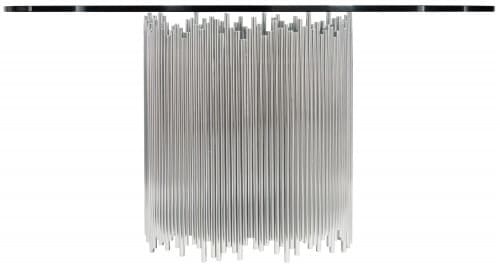
Curated with aloha by
Ted Mooney, P.E. RET

The authoritative public forum
for Metal Finishing 1989-2025

-----
Brush finishing stainless steel

Q. Is it possible to brush finish a shiny stainless steel table?
I'm considering purchasing a dining room table with a shiny stainless steel base. If I wanted it to be refinished with a brushed finish what is involved? And what would be the approximate cost?
- Philadelphia Pennsylvania
A. Hi Sharon. It's probably impractical/impossible to do brush finishing on your table in the sandpaper on automated machinery way described here.
However, the phrase 'brush finish' can mean different things to different people. If, rather than the small parallel sanding lines of brush finishing, you were actually satisfied with a duller, more matte finish, then bead blasting might be practical.
There are far fewer metal finishing shops with the combination of equipment & capabilities that you seek than auto mechanics or plumbers, so when someone asks how much something like this will cost, estimates from 3rd parties without that equipment, those capabilities, and the logistics to handle the job don't really help much :-)
But we can turn your inquiry into an RFQ if you wish, so that shops with the capability to do the job can contact you.
Luck & Regards,

Ted Mooney, P.E. RET
Striving to live Aloha
finishing.com - Pine Beach, New Jersey
March 2022
RFQ: Yes, I would love to know how much it would cost to dull the finish a bit.
Thanks.
- Philadelphia Pennsylvania
March 8, 2022
privately respond to this RFQ
Ed. note: As always, gentle readers: technical replies in public and commercial replies in private please (huh? why?)
⇩ Related postings, oldest first ⇩
Q. I am fabricating a 3 foot railing for a bridge. The railing will be very similar to the everyday stair or walkway wrought iron railing. I would like the railing to match my barbecue that has a brushed stainless steel finish. I am assuming that I should use stainless steel material for strength as opposed to Aluminum. I am going to use round tubing, 1 1/4 dia., and 3/4 dia. How do I get the finish of raw stainless steel tubing to have a nice brushed finish? Is it a plating or good ole sandpaper and some type of finish coating. I have zero knowledge regarding this.....
Thank you,
John RushtonHobbyist - Phoenix, Arizona
2004
A. Brush finishes are indeed done with sandpaper (or artificial sandpapers like Scotchbrite). Usually, though, they are not done in thin swaths by hand or with hand-held sanders, but with a wide belt (up to several foot wide) and one quick scrrrittcchh. These sanding machines are sometimes called "Timesavers" .
because that is one of the most popular brands.
On small parts you may be able to do alright with a quick scrrrittcchh from a hand-held belt sander, but on a long part I think you will find it hard to not have bands where the scratches overlapped.

Ted Mooney, P.E.
Striving to live Aloha
finishing.com - Pine Beach, New Jersey
2003
A. I run a small fabrication shop, and deal with stainless on occasion. It will wear out sanding discs quickly but they will work to remove the mill scale. Use 60 grit as any coarser will leave scratches that are very difficult to remove. The 60 grit will also remove grinder marks. Don't let the metal get overheated, as this could affect the final finish characteristics including corrosion resistance. Then work through 80, and 120 grits. I use an angle grinder
⇦ this on
eBay
or
Amazon [affil links]
, and small right angle grinder on flat surfaces. Then start with scotch brite pads
⇦ this on
eBay or
Amazon [affil links]
beginning with the coarse and working up to the blue or grey for the highest finish. These I also mount on the angle grinder with a 5" hook and loop backer pad, or for the mini grinder I use the 3M roloc pads in 3" or 2" diameter (these also require a special 1/4" arbor backer pad, but you can use the 2" backer for the 3" pad with success especially in high contour areas). All available through MSC, Grainger, or Mcmaster Carr, and online. I spray WD-40
⇦ this on
eBay
or
Amazon [affil links]
on the work while sanding and polishing with the scotch brite pads. As a final touch hand rub the steel with a square pad of scotch brite and WD-40 then wipe clean.
This will leave uniform scratches and will give a consistent appearance. If you are making a tubular railing that isn't arched, then before welding on any posts or brackets you could polish the piece by chucking it in some way to a drill and supporting the other end in a wooden block and then hold abrasive strips or the grinder for that matter over the spinning work. this will leave scratches that are oriented in the short direction but you go up through the grits this way and then hand sand lengthwise after.
- Bloomfield, Connecticut
2006
September 16, 2009
A. A quick and easy way to put round brushed grain lines onto s/s round tubing is get old hand belt sander (wood or metal is fine).
1) Flip the abrasive belt inside out so the abrasive is on the inner surface.
2) Clamp the tubing in a vise horizontally
3)Put the reversed abrasive belt over the tubing (so that the tubing is now going through the belt.
4) Put the DRIVE wheel of the belt sander through the other end of the abrasive belt (Note: the inner abrasive side of the belt will be contacting the drive wheel so it is best to use a sander with a rubber drive wheel)
5) Pull the sander toward you to taught (reduce slack) the belt.
6) Pull the trigger on the sander slowly and work it over the length of the tubing.
7) Be careful and learn the movement of this rig. After a little practice you should be able to do a pretty good job.
We use a modified version of a sander with release/reconnect belts to to touch-up and process handrails on site. Works really well.
All this being said if the handrail is straight with no bends or welds on it yet. Chuck it in a lathe (couple hundred RPM) Then use the belt sander on it with the two set to rotate in opposite directions. Work your way down the length.
We use this method for 20 foot lengths of Schedule 40 2" pipe with no problems.
electropolishing shop - North Vancouver, British Columbia, Canada
Q. Would the same process for sanding the flat surface above work for an unfinished aluminum angle? I have brushed aluminum and would like to match that finish. thanks!
Clarinda Bisceglia- San Mateo, California
May 20, 2010
Q. How can a uniform look of #4 brushed finish be achieved while applying the finish over stainless steel gauge sheet and stainless steel plate. Is there a reason why the finishes shouldn't look the same? How can finish roughness be controlled?
George Haunerarchitect - NYC, New York
January 12, 2011
Q. I am looking at various brushing processes on a stainless product and the question keeps being asked "how much material is removed during the brushing process?" Is there a formula to calculate this or some rule of thumb (i.e., brush time x pressure)? Thanks.
Brian Chisholm- Port Huron, Michigan
January 30, 2013
A. If you got a reply from me privately ignore this. I cannot answer your question without knowing more about what you are trying to accomplish. Also all mechanical systems have different materials of construction to affect surface finishes, plus there is the factor of applying pressure to the transfer media to the part or vice versa.

AF Kenton
retired business owner - Hatboro, Pennsylvania
February 14, 2013
Q. Working on a stainless steel box 14 gauge (.090). It's 19' X 16" x 12" with 3 doors. TIG welding very low heat works great -- but how do you keep this stuff from a heat stain (weld) and warping? And then how to replace or redo the brush finish? Thanks for any help.
Jerry Snow- Beaumont, California, USA
April 19, 2013
A. Sounds like you are going to have to use a hand held wheel system to remove the discoloration. Maybe try a wire brush wheel. Try the alum composition brushes first Maybe a coarse non-woven wheel can also achieve the results. Hopefully you can achieve the results you are looking for in one step.

AF Kenton
retired business owner - Hatboro, Pennsylvania
April 22, 2013
Q, A, or Comment on THIS thread -or- Start a NEW Thread